Characteristics of LDAPS-Predicted Surface Wind Speed and Temperature at Automated Weather Stations with Different Surrounding Land Cover and Topography in Korea
Abstract
:1. Introduction
2. Methodology
2.1. AWS Classification
2.2. LDAPS Data
3. Results and Discussion
4. Summary and Conclusions
Author Contributions
Funding
Acknowledgments
Conflicts of Interest
Appendix A. Heights of the AWSs Considered in this Study and Statistical Details
| Cate Gory | Station Number | Station Height above the Mean Sea Level (m) | MBE (Wind Speeds/Temperature) | RMSE (Wind Speeds/Temperature) | R (Wind Speeds/Temperature) | Cate Gory | Station Number | Station Height above the Mean Sea Level (m) | MBE (Wind Speeds/Temperature) | RMSE (Wind Speeds/Temperature) | R (Wind Speeds/Temperature) |
|---|---|---|---|---|---|---|---|---|---|---|---|
| Uf | 400 | 60 | 1.29/−0.47 | 1.82/1.26 | 0.53/0.95 | Rm | 316 | 912 | −2.38/3.40 | 4.16/3.80 | 0.28/0.92 |
| 401 | 42 | 1.08/−0.88 | 1.52/1.49 | 0.67/0.94 | 318 | 770 | 0.93/0.14 | 1.51/2.29 | 0.76/0.85 | ||
| 402 | 57 | 1.96/−1.02 | 2.47/1.50 | 0.51/0.96 | 320 | 1263 | 0.23/2.19 | 2.36/2.46 | 0.53/0.93 | ||
| 403 | 54 | 1.92/−0.74 | 2.50/1.41 | 0.46/0.95 | 419 | 266 | 0.40/0.93 | 1.79/1.85 | 0.45/0.92 | ||
| 404 | 79 | 1.75/−0.49 | 2.29/1.10 | 0.52/0.95 | 422 | 333 | 0.37/0.67 | 1.41/1.22 | 0.49/0.96 | ||
| 405 | 10 | 1.15/−0.84 | 1.61/1.44 | 0.58/0.94 | 497 | 658 | 2.68/0.50 | 3.36/2.80 | 0.56/0.79 | ||
| 406 | 56 | 1.96/−1.39 | 2.88/2.12 | 0.46/0.93 | 498 | 1015 | 0.60/1.25 | 1.97/1.78 | 0.36/0.93 | ||
| 408 | 49 | 0.96/−0.24 | 1.71/1.39 | 0.47/0.94 | 554 | 770 | −1.69/0.17 | 2.31/1.76 | 0.77/0.87 | ||
| 409 | 40 | 0.63/−0.45 | 0.87/1.29 | 0.54/0.96 | 559 | 575 | 0.95/−0.16 | 1.73/2.64 | 0.72/0.87 | ||
| 410 | 34 | 0.65/−0.05 | 1.10/1.48 | 0.63/0.90 | 579 | 609 | 0.74/0.39 | 1.36/2.28 | 0.64/0.88 | ||
| 413 | 28 | 0.97/−0.47 | 1.37/1.20 | 0.51/0.96 | 581 | 420 | 0.32/−0.68 | 1.27/2.29 | 0.56/0.92 | ||
| 415 | 33 | 1.46/−0.17 | 1.78/1.28 | 0.44/0.94 | 586 | 226 | 0.97/−0.98 | 1.65/2.34 | 0.62/0.92 | ||
| 417 | 42 | 1.32/0.04 | 1.78/1.17 | 0.46/0.95 | 682 | 1062 | −1.06/3.05 | 1.69/3.80 | 0.10/0.85 | ||
| 421 | 34 | 1.40/−0.63 | 1.77/1.45 | 0.45/0.95 | 695 | 1050 | −1.53/2.63 | 2.18/3.00 | 0.22/0.93 | ||
| 423 | 53 | 1.08/−0.18 | 1.54/1.18 | 0.42/0.95 | 735 | 658 | 1.08/0.33 | 1.77/2.48 | 0.64/0.85 | ||
| 424 | 56 | 1.47/−2.67 | 2.00/2.82 | 0.56/0.97 | 759 | 481 | 1.58/−1.49 | 2.94/3.26 | 0.40/0.73 | ||
| 510 | 24 | 1.59/−0.52 | 2.11/1.33 | 0.41/0.94 | 791 | 413 | 1.02/−1.27 | 2.05/2.70 | 0.60/0.81 | ||
| 512 | 9 | 1.03/−0.30 | 1.63/1.45 | 0.50/0.91 | 831 | 662 | 2.07/0.09 | 2.73/2.74 | 0.61/0.77 | ||
| 572 | 29 | 1.07/−0.87 | 1.50/1.79 | 0.62/0.95 | 838 | 452 | 0.95/−1.89 | 1.98/2.62 | 0.64/0.92 | ||
| 627 | 41 | 0.82/0.03 | 1.48/1.41 | 0.69/0.92 | 853 | 570 | 1.89/0.46 | 3.00/1.23 | 0.46/0.95 | ||
| 712 | 9 | 0.86/−0.63 | 1.54/1.24 | 0.75/0.95 | 856 | 514 | 1.78/−1.33 | 2.87/2.26 | 0.62/0.87 | ||
| 788 | 63 | 1.02/−0.27 | 1.68/1.37 | 0.53/0.94 | 870 | 1488 | 0.67/−1.39 | 2.47/2.17 | 0.62/0.84 | ||
| 938 | 109 | 0.75/−0.70 | 1.70/1.55 | 0.59/0.89 | 872 | 865 | 1.66/−2.73 | 3.28/3.55 | 0.46/0.79 | ||
| 940 | 72 | 1.50/−1.05 | 2.46/1.82 | 0.49/0.91 | 875 | 1596 | −0.92/3.04 | 3.31/3.42 | 0.47/0.90 | ||
| 942 | 15 | 1.72/−0.74 | 2.24/1.30 | 0.52/0.92 | 878 | 814 | 1.06/0.86 | 1.87/1.54 | 0.47/0.93 | ||
| Rf | 321 | 254 | 0.34/−0.68 | 1.10/2.12 | 0.71/0.92 | Rc | 300 | 48 | 0.04/0.05 | 1.79/1.10 | 0.74/0.85 |
| 416 | 66 | 0.64/0.87 | 1.02/2.10 | 0.69/0.94 | 301 | 4 | 2.09/−0.10 | 1.83/1.95 | 0.80/0.83 | ||
| 496 | 30 | 0.52/0.58 | 1.20/1.75 | 0.64/0.94 | 310 | 14 | 1.10/0.14 | 1.58/2.39 | 0.58/0.82 | ||
| 529 | 41 | 0.37/0.12 | 1.21/2.16 | 0.57/0.85 | 524 | 3 | 0.48/−0.51 | 1.78/2.49 | 0.49/0.83 | ||
| 602 | 93 | 0.67/0.01 | 1.29/1.69 | 0.67/0.93 | 606 | 24 | 1.60/−0.17 | 2.11/1.49 | 0.69/0.87 | ||
| 603 | 120 | 0.48/0.16 | 1.29/1.92 | 0.72/0.94 | 607 | 7 | 2.00/−0.25 | 2.32/1.55 | 0.75/0.84 | ||
| 615 | 12 | 0.26/0.24 | 1.01/1.30 | 0.70/0.97 | 631 | 9 | 1.24/−0.35 | 1.87/1.53 | 0.72/0.85 | ||
| 622 | 93 | 0.54/0.33 | 1.32/2.24 | 0.75/0.92 | 657 | 32 | 1.07/−0.12 | 1.99/1.43 | 0.57/0.84 | ||
| 623 | 75 | 0.65/−0.54 | 1.43/1.73 | 0.71/0.95 | 661 | 5 | 0.14/0.49 | 1.57/3.05 | 0.48/0.71 | ||
| 701 | 205 | 0.34/0.89 | 1.08/2.24 | 0.55/0.92 | 662 | 14 | 1.70/0.29 | 2.55/1.17 | 0.69/0.85 | ||
| 706 | 49 | −0.12/0.18 | 1.10/1.51 | 0.69/0.94 | 663 | 60 | 0.51/0.55 | 2.77/1.03 | 0.77/0.91 | ||
| 708 | 30 | 0.49/−0.10 | 1.26/1.30 | 0.77/0.94 | 671 | 3 | 1.39/−0.43 | 1.84/2.60 | 0.52/0.70 | ||
| 710 | 9 | 0.36/0.16 | 1.25/1.56 | 0.79/0.93 | 697 | 4 | 1.35/−0.08 | 3.04/1.04 | 0.72/0.87 | ||
| 775 | 51 | 0.33/0.47 | 1.08/1.33 | 0.82/0.96 | 700 | 52 | 1.24/0.34 | 2.68/1.06 | 0.65/0.92 | ||
| 816 | 42 | 0.54/0.19 | 1.32/1.55 | 0.73/0.89 | 793 | 3 | 0.43/−0.06 | 1.81/1.06 | 0.81/0.95 | ||
| 825 | 30 | 0.11/−0.63 | 0.95/1.83 | 0.67/0.93 | 800 | 9 | 0.81/−0.56 | 1.76/2.02 | 0.57/0.80 | ||
| 829 | 71 | 0.38/−0.16 | 1.13/1.70 | 0.77/0.94 | 852 | 41 | 0.61/0.14 | 1.67/1.71 | 0.75/0.91 | ||
| 841 | 137 | 0.37/0.44 | 0.94/2.56 | 0.70/0.89 | 881 | 13 | 1.20/−0.13 | 1.70/1.53 | 0.54/0.82 | ||
| 887 | 33 | 0.31/−0.06 | 1.04/1.54 | 0.73/0.94 | 901 | 68 | 1.08/−0.42 | 1.99/1.45 | 0.65/0.90 | ||
| 900 | 122 | 0.62/−0.36 | 1.42/2.40 | 0.72/0.87 | 907 | 23 | 1.27/−0.55 | 2.17/1.31 | 0.59/0.89 | ||
| 920 | 8 | 0.52/0.37 | 1.28/1.73 | 0.73/0.94 | 921 | 74 | 1.54/0.01 | 2.98/1.44 | 0.62/0.88 | ||
| 925 | 12 | 0.51/0.71 | 1.32/1.50 | 0.69/0.94 | 923 | 66 | 1.02/−0.29 | 1.87/1.12 | 0.64/0.91 | ||
| 932 | 8 | 0.72/−0.68 | 1.24/1.30 | 0.53/0.95 | 924 | 24 | 1.28/−0.27 | 1.94/1.13 | 0.60/0.90 | ||
| 946 | 324 | 0.22/−0.35 | 1.00/2.34 | 0.69/0.88 | 949 | 4 | 0.52/−0.49 | 1.45/1.87 | 0.62/0.85 | ||
| 951 | 103 | 0.35/0.76 | 1.33/1.88 | 0.70/0.92 | 954 | 63 | 0.75/−0.26 | 1.65/1.53 | 0.61/0.92 |
References
- Kinney, P.L. Climate change, air quality, and human health. Am. J. Prev. Med. 2008, 35, 459–467. [Google Scholar] [CrossRef] [PubMed]
- Neumayer, E.; Plumper, T.; Barthel, F. The political economy of natural disaster damage. Glob. Environ. Chang. 2014, 24, 8–19. [Google Scholar] [CrossRef] [Green Version]
- Lesk, C.; Rowhani, P.; Ramankutty, N. Influence of extreme weather disasters on global crop production. Nature 2016, 529, 84. [Google Scholar] [CrossRef] [PubMed]
- Ayugi, B.; Tan, G.; Rouyun, N.; Zeyao, D.; Ojara, M.; Mumo, L.; Ongoma, V. Evaluation of meteorological drought and flood scenarios over Kenya, East Africa. Atmosphere (Basel) 2020, 11, 307. [Google Scholar] [CrossRef] [Green Version]
- Koetse, M.J.; Rietveld, P. The impact of climate change and weather on transport: An overview of empirical findings. Transp. Res. Part D Transp. Environ. 2009, 14, 205–221. [Google Scholar] [CrossRef]
- Rutty, M.; Andrey, J. Weather forecast use for winter recreation. Weather Clim. Soc. 2014, 6, 293–306. [Google Scholar] [CrossRef]
- Ziolkowska, J.R. Economic value of environmental and weather information for agricultural decisions-a case study for Oklahoma Mesonet. Agric. Ecosyst. Environ. 2018, 265, 503–512. [Google Scholar] [CrossRef]
- Song, B.H. A case study of the meteorological industry for the media in the USA for promotion of private sector meteorological industry in the Republic of Korea: Based on the weather channel case. Atmosphere 2014, 24, 253–263, (In Korean with English Abstract). [Google Scholar] [CrossRef] [Green Version]
- Kim, H.J.; Kim, J.I.; Son, H.C. A study on the economic effects of the meteorological industry. J. Environ. Policy Adm. 2019, 27, 163–184. [Google Scholar]
- Jeong, J.; Lee, S.-J. A statistical parameter correction technique for WRF medium-range prediction of near-surface temperature and wind speed using generalized linear model. Atmosphere (Basel) 2018, 9, 291. [Google Scholar] [CrossRef] [Green Version]
- Lee, J.; Shin, H.H.; Hong, S.Y.; Jiménez, P.A.; Dudhia, J.; Hong, J. Impacts of subgrid-scale orography parameterization on simulated surface layer wind and monsoonal precipitation in the high-resolution WRF model. J. Geophys. Res. Atmos. 2015, 120, 644–653. [Google Scholar] [CrossRef]
- Kwun, J.H.; Kim, Y.K.; Seo, J.W.; Jeong, J.H.; You, S.H. Sensitivity of MM5 and WRF mesoscale model predictions of surface winds in a typhoon to planetary boundary layer parameterizations. Nat. Hazards 2009, 51, 63–77. [Google Scholar] [CrossRef]
- Shin, Y.; Yi, C. Statistical downscaling of urban-scale air temperatures using an analog model output statistics technique. Atmosphere (Basel) 2019, 10, 427. [Google Scholar] [CrossRef] [Green Version]
- Kim, D.J.; Lee, D.I.; Kim, J.-J.; Park, M.S.; Lee, S.H. Development of a building-scale meteorological prediction system including a realistic surface heating. Atmosphere (Basel) 2020, 11, 67. [Google Scholar] [CrossRef] [Green Version]
- Lee, D.B.; Chun, H.Y. Development of the Korean Peninsula-Korean aviation turbulence guidance (KP-KTG) system using the local data assimilation and prediction system (LDAPS) of the Korea Meteorological Administration (KMA). Atmosphere 2015, 25, 367–374, (In Korean with English Abstract). [Google Scholar] [CrossRef] [Green Version]
- Kim, D.Y.; Kim, T.W.; Oh, G.J.; Huh, J.C.; Ko, K.N. A comparison of ground-based LiDAR and met mast wind measurements for wind resource assessment over various terrain conditions. J. Wind. Eng. Ind. Aerod. 2016, 158, 109–121. [Google Scholar] [CrossRef]
- Park, S.-U.; Lee, I.-H.; Joo, S.J.; Ju, J.-W. Emergency preparedness for the accidental release of radionuclides from the Uljin Nuclear Power Plant in Korea. J. Environ. Radioact. 2017, 180, 90–105. [Google Scholar] [CrossRef]
- Kang, M.S.; Lim, Y.-K.; Cho, C.B.; Kim, K.R.; Park, J.S.; Kim, B.-J. The sensitivity analyses of initial condition and data assimilation for a fog event using the mesoscale meteorological model. J. Korean Earth Sci. 2015, 36, 567–579, (In Korean with English Abstract). [Google Scholar] [CrossRef]
- Yi, C.; Shin, Y.; Roh, J.W. Development of an urban high-resolution air temperature forecast system for local weather information services based on statistical downscaling. Atmosphere (Basel) 2018, 9, 164. [Google Scholar] [CrossRef] [Green Version]
- Wie, J.; Hong, S.O.; Byon, J.Y.; Ha, J.C.; Moon, B.K. Sensitivity analysis of surface energy budget to albedo parameters in Seoul metropolitan area using the Unified Model. Atmosphere (Basel) 2020, 11, 120. [Google Scholar] [CrossRef] [Green Version]
- Simón-Moral, A.; Dipankar, A.; Roth, M.; Sánchez, C.; Velasco, E.; Huang, X.Y. Application of MORUSES single-layer urban canopy model in a tropical city: Results from Singapore. Q. J. R. Meteorol. Soc. 2020, 146, 576–597. [Google Scholar] [CrossRef]
- Harris, P.P.; Folwell, S.S.; Gallego-Elvira, B.; Rodríguez, J.; Milton, S.; Taylor, C.M. An evaluation of modeled evaporation regimes in Europe using observed dry spell land surface temperature. J. Hydrometeorol. 2017, 18, 1453–1470. [Google Scholar] [CrossRef] [Green Version]
- Unnikrishnan, C.K.; Gharai, B.; Mohandas, S.; Mamgain, A.; Rajagopal, E.N.; Iyengar, G.R.; Rao, P.V.N. Recent changes on land use/land cover over Indian region and its impact on the weather prediction using Unified model. Atmos. Sci. Lett. 2016, 17, 294–300. [Google Scholar]
- Golding, B.W.; Ballard, S.P.; Mylne, K.; Roberts, N.; Saulter, A.; Wilson, C.; Simonin, D. Forecasting capabilities for the London 2012 Olympics. Bull. Am. Meteorol. Soc. 2014, 95, 883–896. [Google Scholar] [CrossRef]
- Kwon, Y.-A.; Lee, H.-Y. The characteristics of air temperature distribution by land-use type—A case study of around automatic weather station in Seoul. J. Environ. Impact Asses. 2003, 12, 281–290, (In Korean with English Abstract). [Google Scholar]
- Sung, C.-J. A study on the analysis of terrain element and terrain classification using GIS. Geogr. J. Korea 2003, 37, 155–161, (In Korean with English Abstract). [Google Scholar]
- Lee, J.W.; Kim, Y.S. Coastline change analysis using RTK-GPS and aerial photo. J. Korean Soc. Surv. 2007, 25, 191–198, (In Korean with English Abstract). [Google Scholar]
- Prasanna, V.; Choi, H.-W.; Jung, J.; Lee, Y.G.; Kim, B.J. High-resolution wind simulation over Incheon international airport with the Unified Model’s Rose Nesting Suite from KMA operational forecasts. Asia Pac. J. Atmos. Sci. 2018, 54, 187–203. [Google Scholar] [CrossRef]
- Walters, D.N.; Williams, K.D.; Boutle, I.A.; Bushell, A.C.; Edwards, J.M.; Field, P.R.; Willett, M.R. The Met Office Unified Model global atmosphere 4.0 and JULES global land 4.0 configurations. Geosci. Model Dev. 2014, 7, 361–386. [Google Scholar] [CrossRef] [Green Version]
- Charney, J.G.; Phillips, N.A. Numerical integration of the quasi-geostrophic equations for barotropic and simple baroclinic flows. J. Atmos. Sci. 1953, 10, 71–99. [Google Scholar] [CrossRef] [Green Version]
- Davies, T.; Cullen, M.J.P.; Malcolm, A.J.; Mawson, M.H.; Staniforth, A.; White, A.A.; Wood, N. A new dynamical core for the Met Office’s global and regional modelling of the atmosphere. Q. J. R. Meteorol. Soc. 2005, 131, 1759–1782. [Google Scholar] [CrossRef]
- Lock, A.P.; Brown, A.R.; Bush, M.R.; Martin, G.M.; Smith, R.N.B. A new boundary layer mixing scheme. Part 1: Scheme description and single-column model tests. Mon. Weather Rev. 2000, 128, 3187–3199. [Google Scholar] [CrossRef]
- Edwards, J.M.; Slingo, A. Studies with a flexible new radiation code. 1: Choosing a configuration for a large-scale model. Q. J. R. Meteor. Soc. 1996, 122, 689–719. [Google Scholar] [CrossRef]
- De Rooy, W.C.; Kok, K. A combined physical–statistical approach for the downscaling of model wind speed. Weather Forecast. 2004, 19, 485–495. [Google Scholar] [CrossRef]
- Yu, M.; Wu, B.; Zeng, H.; Xing, Q.; Zhu, W. The impacts of vegetation and meteorological factors on aerodynamic roughness length at different time scales. Atmosphere (Basel) 2018, 9, 149. [Google Scholar] [CrossRef] [Green Version]
- Sun, W.; Liu, Z.; Zhang, Y.; Xu, W.; Lv, X.; Liu, Y.; Lyu, H.; Li, X.; Xiao, J.; Ma, F. Study on land-use changes and their impacts on air pollution in Chengdu. Atmosphere (Basel) 2020, 11, 42. [Google Scholar] [CrossRef] [Green Version]
- Best, M.J. Representing urban areas within operational numerical weather prediction models. Bound. Lay. Meteorol. 2005, 114, 91–109. [Google Scholar] [CrossRef]
- Salamanca, F.; Zhang, Y.; Barlage, M.; Chen, F.; Mahalov, A.; Miao, S. Evaluation of the WRF-urban modeling system coupled to Noah and Noah-MP land surface models over a semiarid urban environment. J. Geophys. Res. Atmos. 2018, 123, 2387–2408. [Google Scholar] [CrossRef]
- Gross, G. On the parametrization of urban land use in mesoscale models. Bound. Lay. Meteorol. 2014, 150, 319–326. [Google Scholar] [CrossRef]
- Revell, M.J.; Purnell, D.; Lauren, M.K. Requirements for large-eddy simulation of surface wind gusts in a mountain valley. Bound. Lay. Meteorol. 1996, 80, 333–353. [Google Scholar] [CrossRef]
- Fast, J.D. Forecasts of valley circulations using the terrain-following and step-mountain vertical coordinates in the Meso-Eta model. Weather Forecast. 2003, 18, 1192–1206. [Google Scholar] [CrossRef]
- Jiménez, P.A.; Dudhia, J. Improving the representation of resolved and unresolved topographic effects on surface wind in the WRF model. J. Appl. Meteorol. Clim. 2012, 51, 300–316. [Google Scholar] [CrossRef] [Green Version]
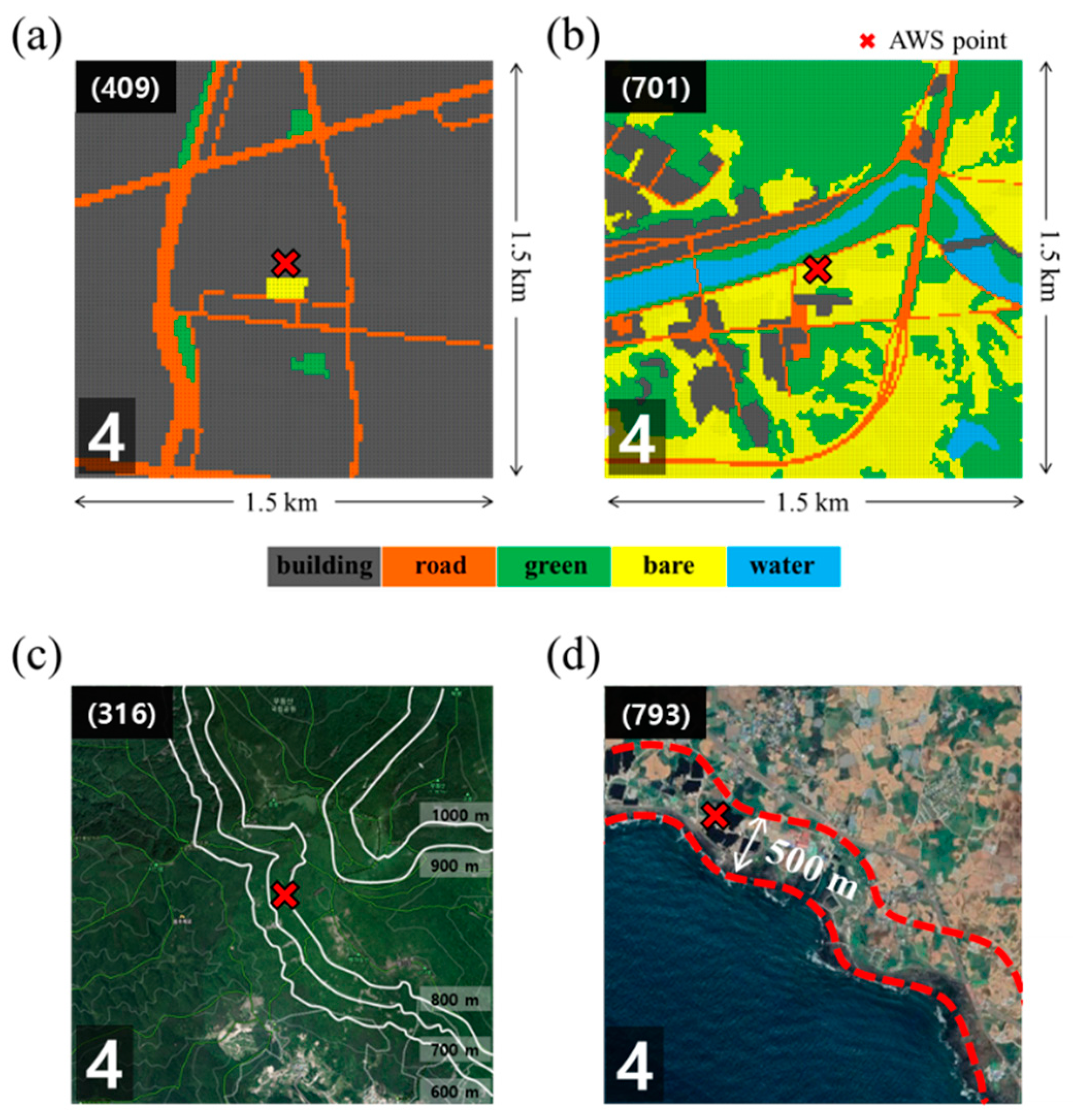
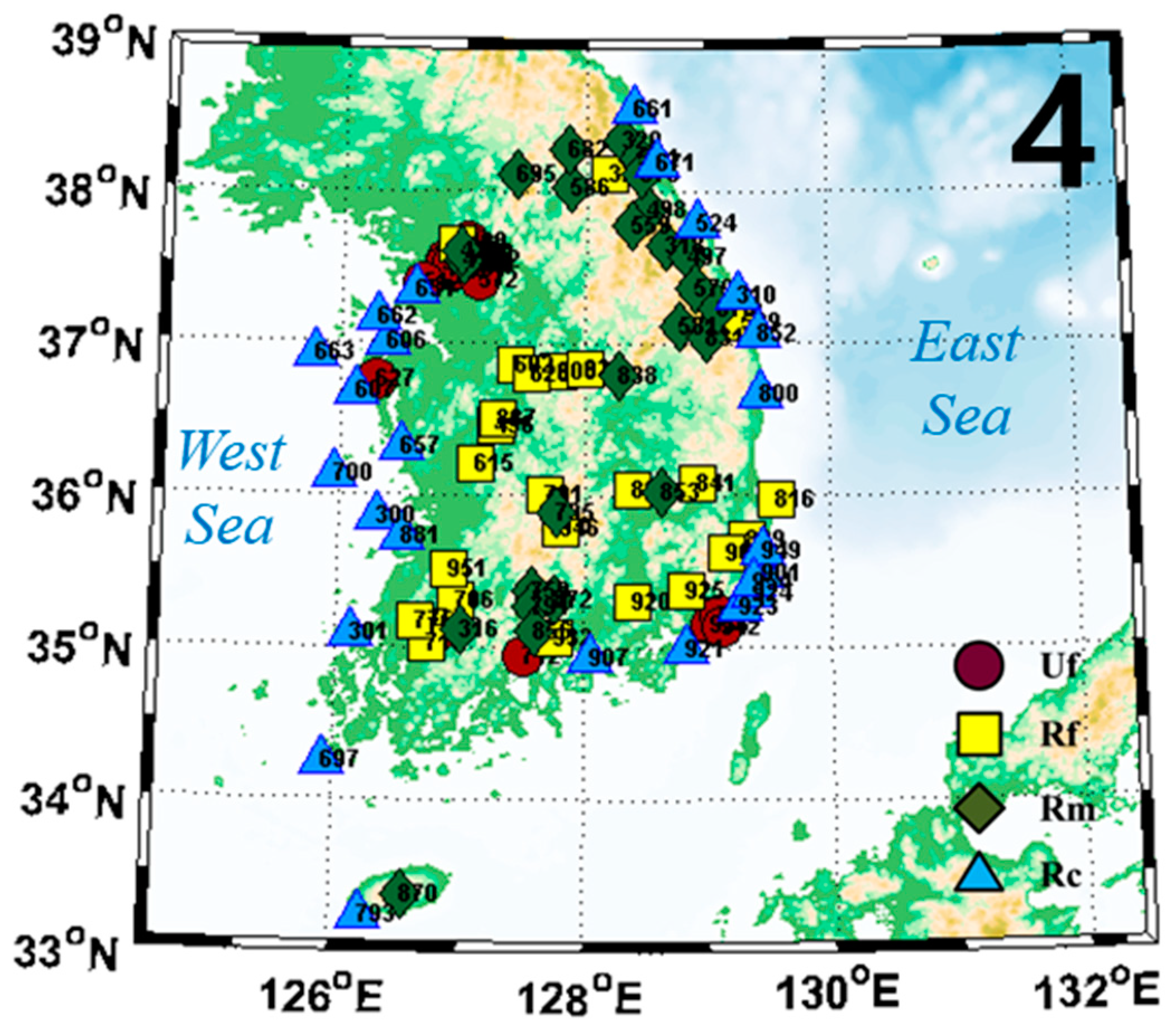
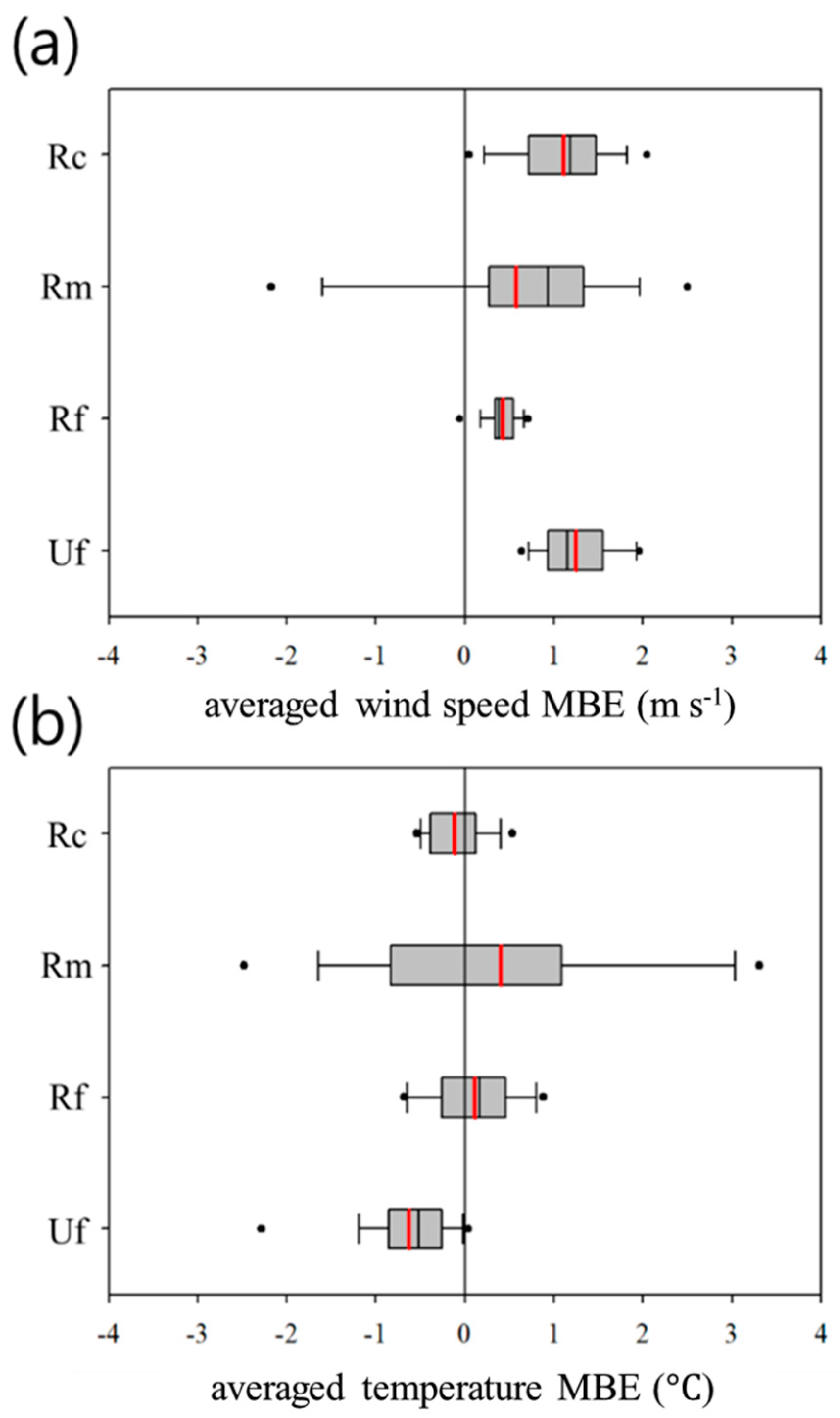
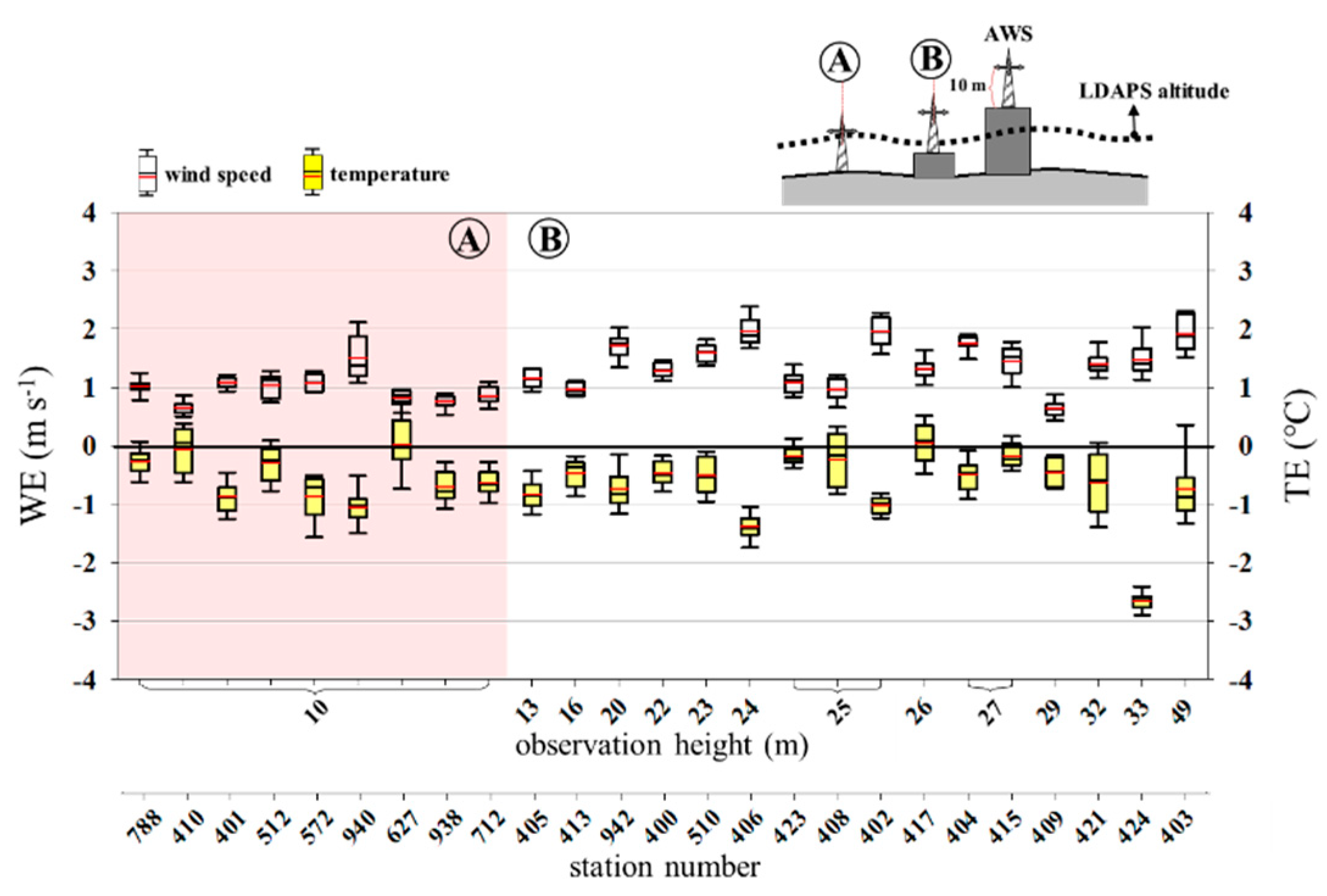
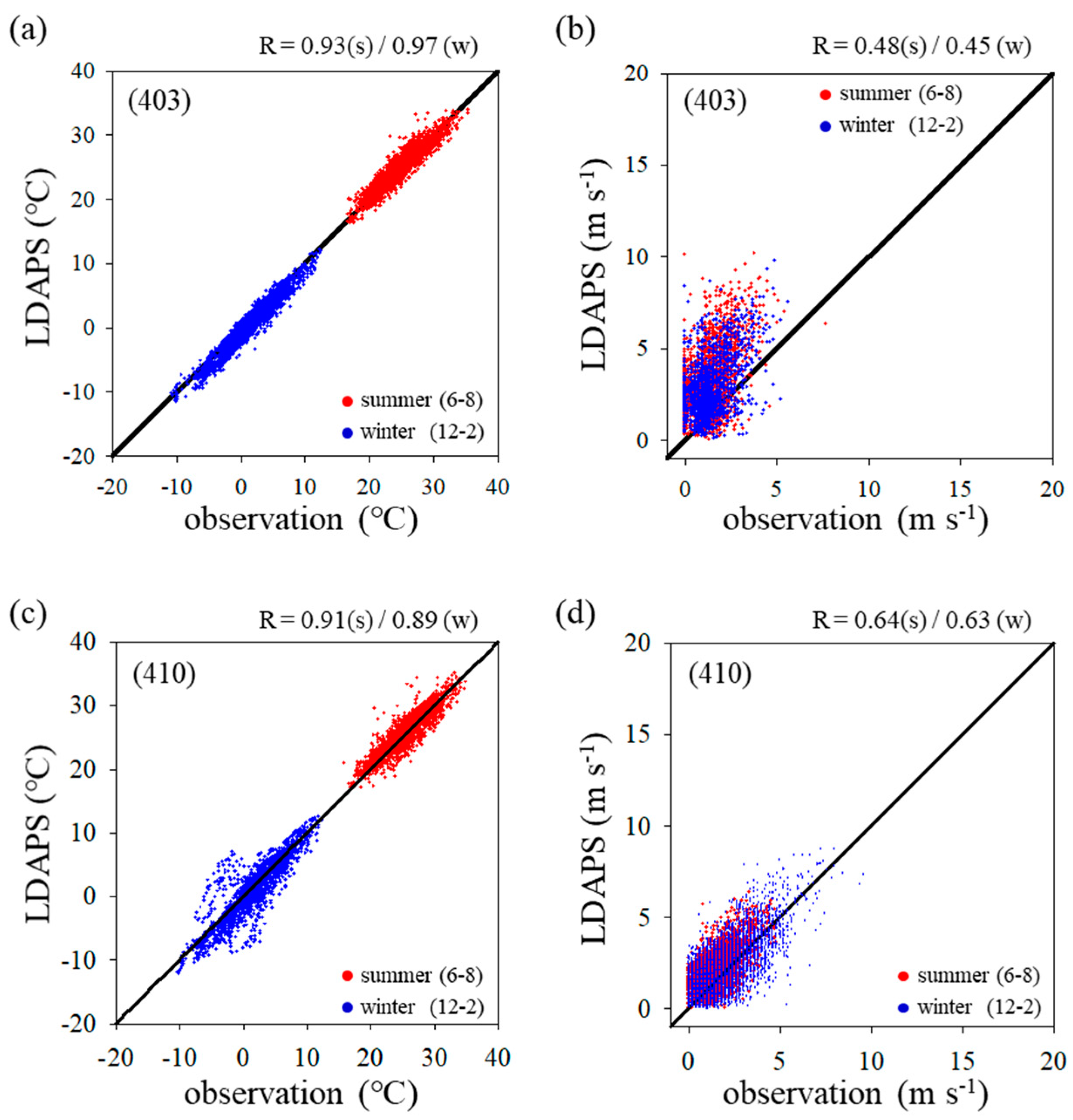

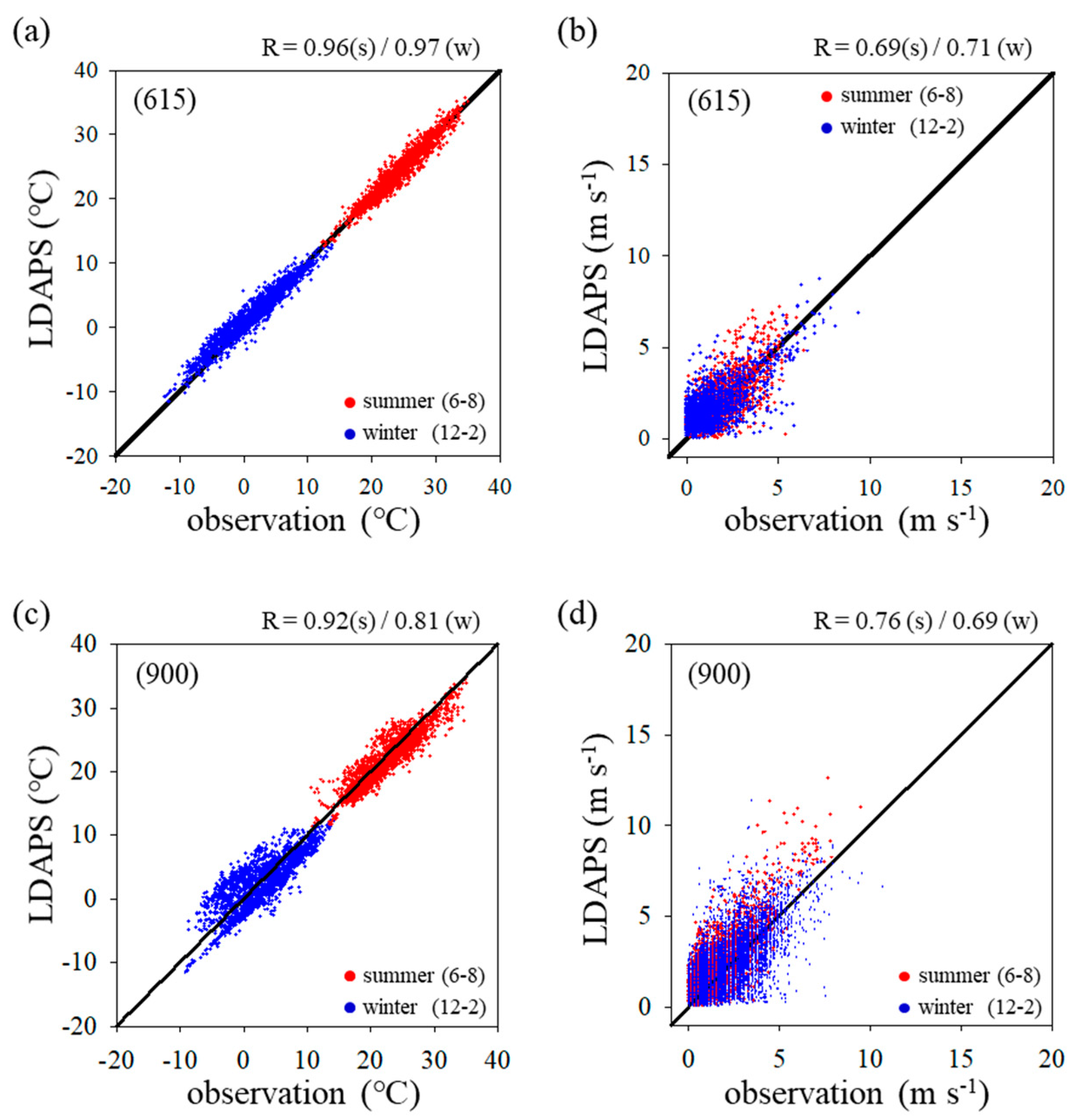
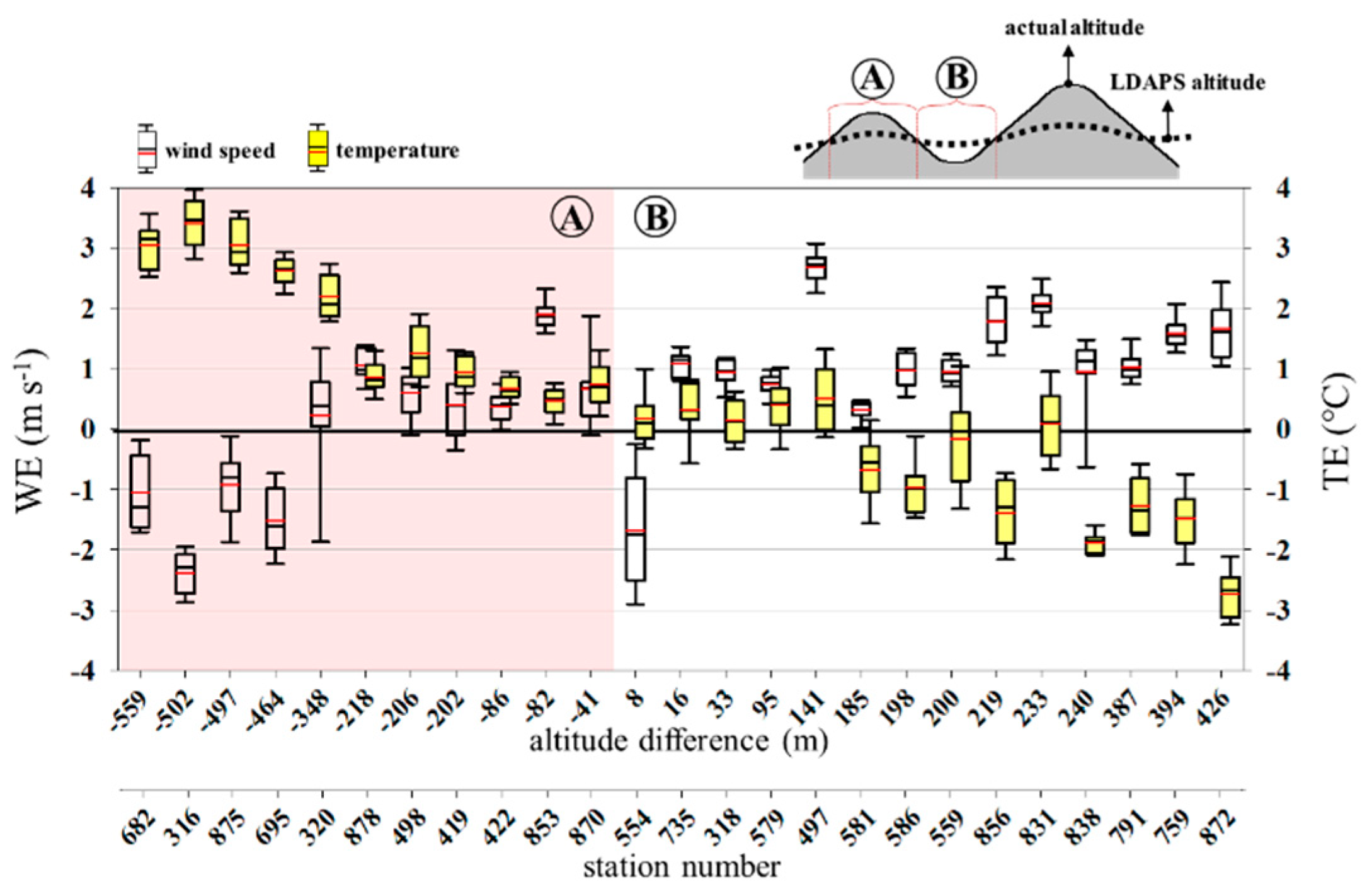
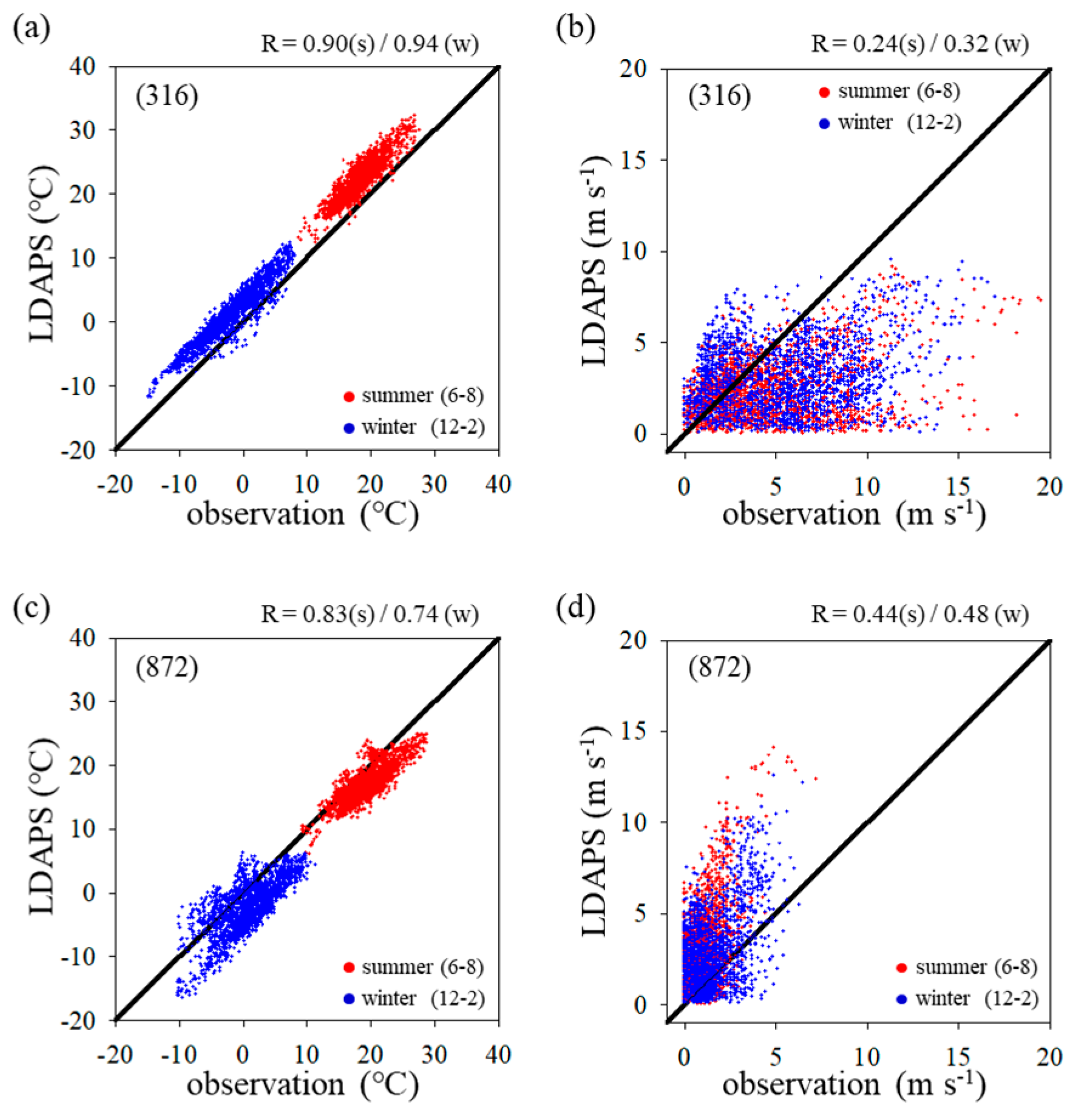
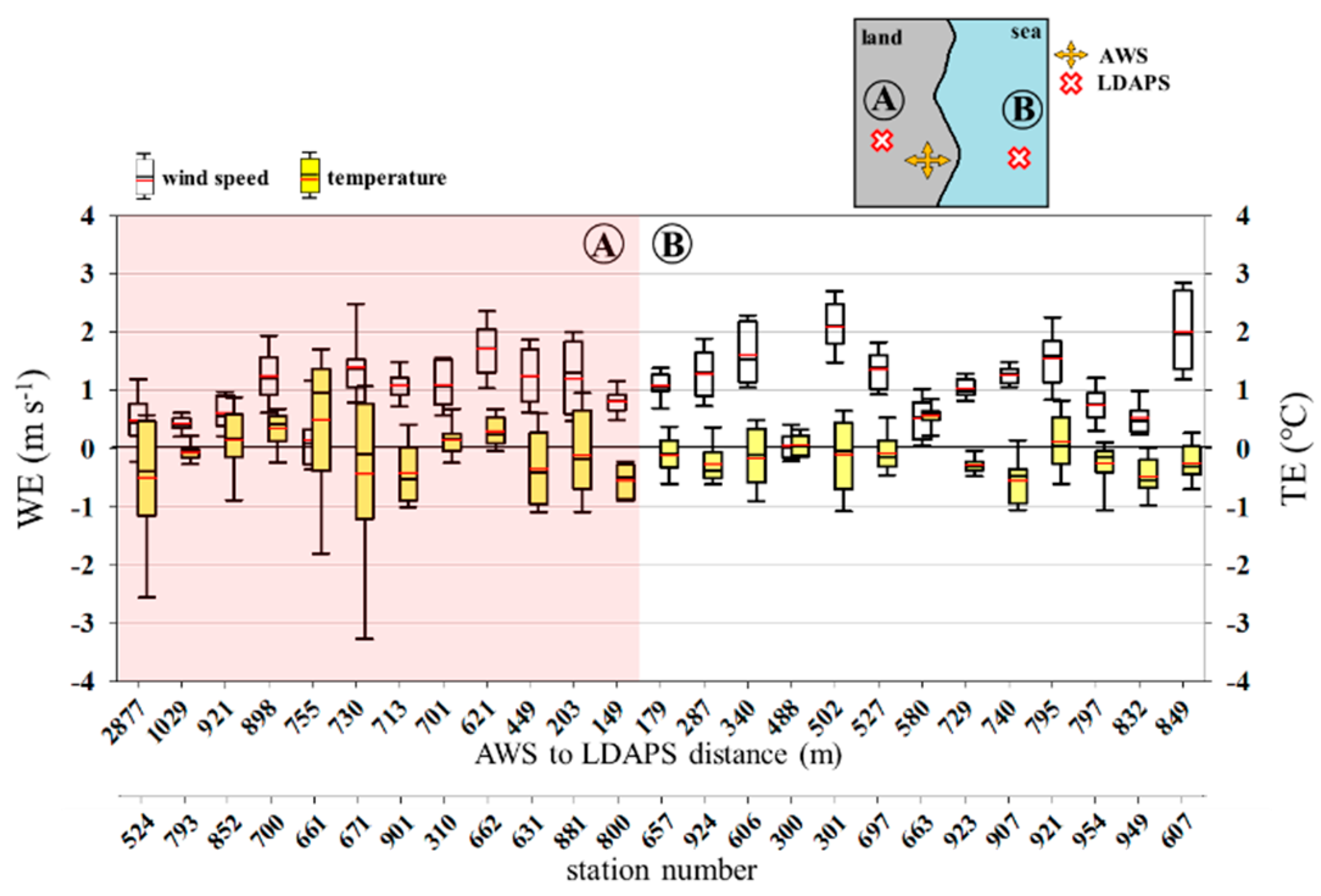
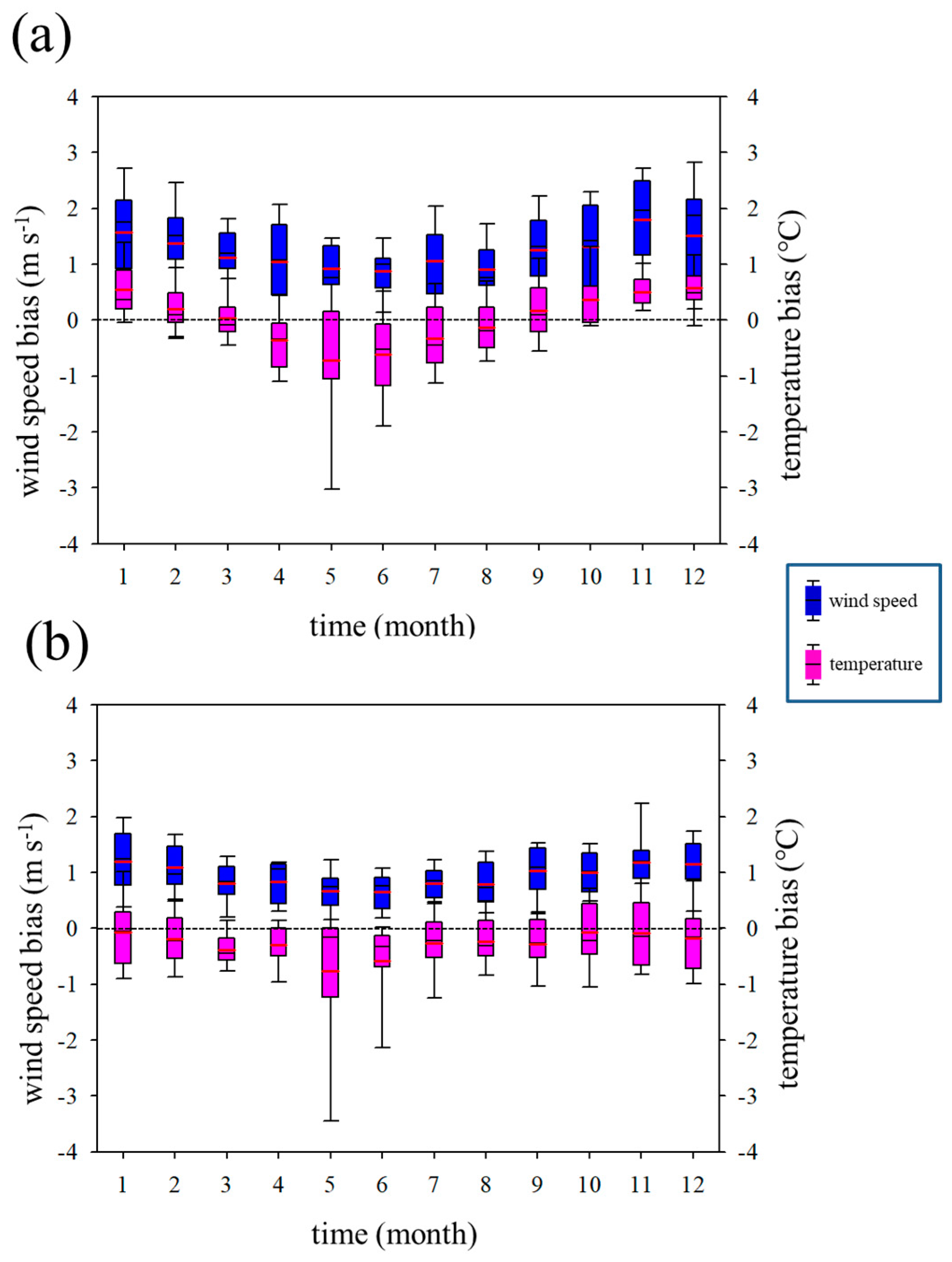
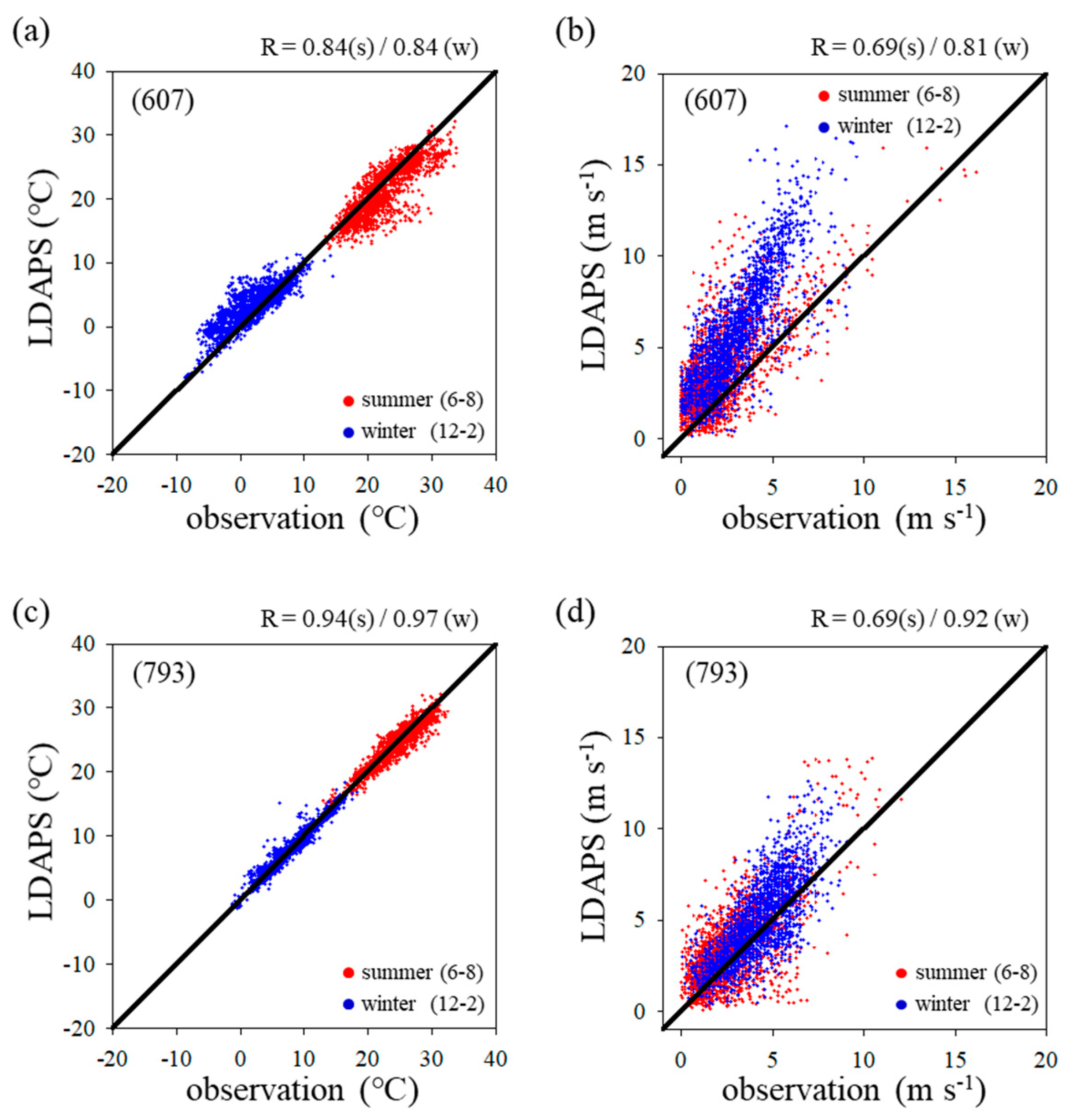
| Model | LDAPS (UM 1.5 km L70) |
| Basic model | UK Met Office Unified Model (UM) Vn 8.2 |
| horizontal grid dimension | variable grid (total): 744 × 928fixed grid (inner): 622 × 810 |
| horizontal grid size (km) (inner) | 1.5 |
| dynamics core | New Dynamics |
| horizontal grid system | Arakawa C-grid |
| vertical layers | 70 (eta level) (~40 km) |
| time step | 50 s |
| time integration | semi-implicit semi-Lagrangian scheme |
| vertical grid system | Charney-Phillips staggered grid |
| boundary conditions | Global Data Assimilation and Prediction System (GDAPS) |
| data assimilation | 3DVAR/latent heat nudging |
| radiative process | Edward-Slingo general 2-stream scheme |
| land surface process | JULES (Joint UK Land Environment Simulator) land-surface scheme |
| microphysics | mixed-phase scheme with graupel |
| planetary boundary layer | non-local scheme with revised diagnosis of K profile depth |
| gravity wave drag | gravity wave drag due to orography |
| Category | Prediction Characteristics of LDAPS Model | |
|---|---|---|
| Wind Speed | Temperature | |
| Uf | ▪ If an AWS located on the ground →= 0.27 m s−1 ▪ If an AWS located on the building →= 0.28 m s−1 | ▪ If an AWS located on the ground → ▪ If an AWS located on the building → |
| Rf | ▪ = 0.22 m s−1 | ▪ If (LDAPS—actual altitude) < 0 m → ▪ If (LDAPS—real-terrain altitude) > 0 m → |
| Rm | ▪ If (LDAPS—actual altitude) < −400m →= 0.85 m s−1 ▪ If (LDAPS—real-terrain altitude) > −400m →= 0.47 m s−1 | ▪ If (LDAPS—actual altitude) < 150 m → ▪ If (LDAPS—actual altitude) > 150 m → |
| Rc | ▪ If LDAPS grid located on the land →= 0.57 m s−1 ▪ If LDAPS grid located on the sea →= 0.54 m s−1 | ▪ If LDAPS grid located on the land → ▪ If LDAPS grid located on the sea → |
Publisher’s Note: MDPI stays neutral with regard to jurisdictional claims in published maps and institutional affiliations. |
© 2020 by the authors. Licensee MDPI, Basel, Switzerland. This article is an open access article distributed under the terms and conditions of the Creative Commons Attribution (CC BY) license (http://creativecommons.org/licenses/by/4.0/).
Share and Cite
Kim, D.-J.; Kang, G.; Kim, D.-Y.; Kim, J.-J. Characteristics of LDAPS-Predicted Surface Wind Speed and Temperature at Automated Weather Stations with Different Surrounding Land Cover and Topography in Korea. Atmosphere 2020, 11, 1224. https://doi.org/10.3390/atmos11111224
Kim D-J, Kang G, Kim D-Y, Kim J-J. Characteristics of LDAPS-Predicted Surface Wind Speed and Temperature at Automated Weather Stations with Different Surrounding Land Cover and Topography in Korea. Atmosphere. 2020; 11(11):1224. https://doi.org/10.3390/atmos11111224
Chicago/Turabian StyleKim, Dong-Ju, Geon Kang, Do-Yong Kim, and Jae-Jin Kim. 2020. "Characteristics of LDAPS-Predicted Surface Wind Speed and Temperature at Automated Weather Stations with Different Surrounding Land Cover and Topography in Korea" Atmosphere 11, no. 11: 1224. https://doi.org/10.3390/atmos11111224
APA StyleKim, D.-J., Kang, G., Kim, D.-Y., & Kim, J.-J. (2020). Characteristics of LDAPS-Predicted Surface Wind Speed and Temperature at Automated Weather Stations with Different Surrounding Land Cover and Topography in Korea. Atmosphere, 11(11), 1224. https://doi.org/10.3390/atmos11111224






